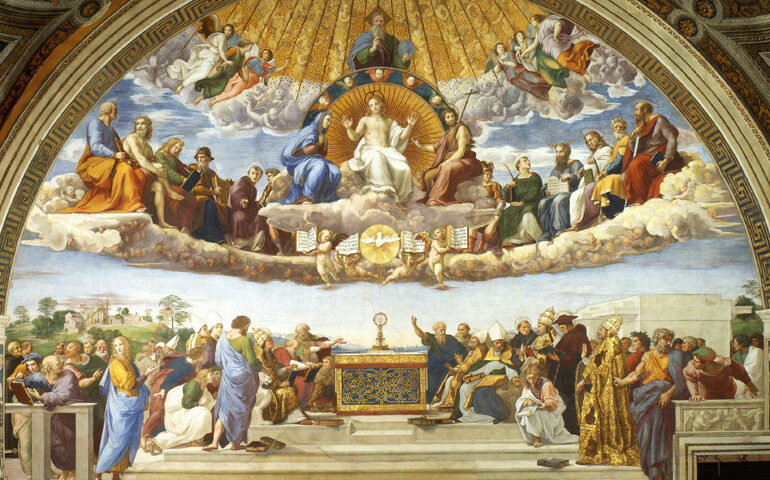
The third great of the Italian Renaissance, along with Leonardo and Michelangelo, is one of the great art references of all time. The regular visitors to the Vatican Museums The customary speed of the tours does not always allow us to appreciate the rich combination of art and culture. theology of most of his works. But, in addition to the political correctnesswithout any subtlety in its analysis, leaves room for formalistic evaluations and historical judgments of those in which there is only good or bad.
Raphael Sanzio (1483 - 1520) was a painter who had everything to succeed in the artistic world and in society: youth, sympathy, charisma among his disciples, patronage of the nobility and the papacy... Giorgio Vasari, the well-known biographer of Italian artists, even describes him as a hedonist because of his riches, honors or relationships with women. And what to say about the Papa Julius II, one of his main protectors, was he not the Pontiff who had the old Vatican basilica demolished, who wore the armor in wars against other Italian states and who wanted to turn Rome Did the Augustinian monk Martin Luther not have enough arguments to describe papal Rome as Babylon, when he surrounded himself with the most prestigious artists of the early 16th Century?

Raphael Sanzio's 'Disputation of the Sacrament' in the Vatican Museums
Just a few years later, the imperial troops of Charles V were sacking the cityand among them, there was an abundance of soldiers who had embraced the Lutheran faith. They entered the Vatican chambers and left graffiti on one of Raphael's frescoes, The Disputation of the Sacramento.
My first conclusion is that some of them were not ignorant; at a time when few could read and write, they had imbibed Luther's criticisms. The point of the swords left the names of the German reformer and Charles V on Raphael's painting.
It brought together, and not exactly for the good, two enemies irreconcilable. On the other hand, those new Puritans, heralds of times of scarcity for works of art and libraries, did not even deprive themselves of desecrating the tomb of Julius II in search of riches.
It strikes me that these graffiti were not covered in the five centuries that have passed. I doubt very much that it was due to carelessness or forgetfulness. I dare to venture that they were left as a testimony of the fragility of the human. That Church of splendorous artistic works, represented by Popes such as Julius II and Leo X, and who dreamed of the Rome's rebirthHe seemed to have forgotten that hatreds and ambitions were capable of taking everything by surprise. According to some experts, Julius III's commission to Michelangelo to paint the frescoes of the Final Judgment is related to the dramatic sacking of Rome.
The Lutheran soldiers respected The School of Athens, Raphael's other fresco in the same Vatican room. It is true that The Disputation of the Sacrament is the most visible work on entering the room, and it is almost certain that the subject of the painting irritated the fanatical soldiers. The center of the work is a monstrance on an altar. It is located on the plane of the Church militant, well differentiated from the triumphant in the two spaces of the composition. However, the Eucharist is not the subject of any dispute, as the traditional title of the work suggests. It should be called The Triumph of the Eucharist or The Triumph of the Church. The characters depicted seem to be in contemplation or in pleasant contemplation. dialogue next to the monstrance. It is significant that there are both Old and New Testaments, and not separated but mixed together.
Cardinal Ravasi is quite right in pointing out that Raphael was both artist and theologian, either on his own initiative or at the direction of his patrons. Jesus did not come to abolish the Law and the prophets (Mt 5:17). Hence, St. Peter, Adam, St. John the Evangelist, King David, St. Stephen, St. Jeremiah, Judas Maccabeus, St. Lawrence, Moses, Abraham and St. Paul are depicted. Also represented are Popes and Church Fathers such as St. Gregory the Great, St. Jerome, St. Ambrose, St. Augustine, St. Bonaventure, Innocent III and Sixtus IV. Surprisingly, Dante Alighieri and the Dominican monk Savonarola, condemned as a heretic by Alexander VI, an adversary Pope of Julius II, also appear.
What is fundamental in this fresco is that the mystery of the Eucharist unites heaven with earth. At the top is the Trinity, the Virgin, St. John the Baptist and the four Gospels, for the Word cannot be separated from the Bread.
Antonio R. Rubio Plo
Degree in History and Law
International writer and analyst
@blogculturayfe / @arubioplo